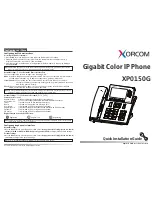
IP Phone SIP Admin Guide 25
C
o
n
fi
g
u
r
in
g
t
h
e
I
P
P
h
o
n
e
4 In the "Outbound Proxy Port"
field, enter a port number for
accessing the outbound proxy
server.
5 In the "Session Timer" field,
enter the time, in seconds, that
the IP phone uses to send peri-
odic re-
INVITE
requests to keep
a session alive. The proxy uses
these re-
INVITE
requests to
maintain the status' of the con-
nected sessions. See RFC4028
for details.
6 In the "Timer 1 and Timer 2"
fields, enter a time, in seconds,
that will apply to an IP phone
session. These timers are SIP
transaction layer timers defined
in RFC 3261.
Timer 1 is an estimate of the
round-trip time (RTT). Default
is 500 msec.
Timer 2 represents the amount
of time a non-INVITE server
transaction takes to respond to a
request. Defaults is 4 seconds.
7 In the "Transport Protocol"
field, select a transport protocol
to use when sending SIP Real-
time Transport Protocol (RTP)
packets. Valid values are User
Datagram Protocol (UDP),
Transmission Control Protocol
(TCP), or both.
8 Click to save your
changes.
Real-time Transport
Protocol (RTP) Settings
Real-time Transport Protocol
(RTP) is used as the bearer path for
voice packets sent over the IP
network. Information in the RTP
header tells the receiver how to
reconstruct the data and describes
how the bit streams are packetized
(i.e. which codec is in use). Real-
time Transport Control Protocol
(RTCP) allows endpoints to
monitor packet delivery, detect
and compensate for any packet
loss in the network. Session
Initiation Protocol (SIP) and H.323
both use RTP and RTCP for the
media stream, with User Datagram
Protocol (UDP) as the transport
layer encapsulation protocol.
Note: If RFC2833 relay of DTMF tones
is configured, it is sent on the
same port as the RTP voice pack-
ets.
RTP is described in RFC1889. The
UDP port used for RTP streams is
traditionally an even-numbered
port, and the RTCP control is on
the next port up. A phone call
therefore uses one pair of ports for
each media stream.
On the Aastra IP phone, the initial
port used as the starting point for
RTP/RTCP port allocation can be
configured using "RTP Port Base".
The default RTP base port on the
IP phones is 3000.
For example, if the RTP base port
value is 5000, the first voice patch
sends RTP on port 5000 and RTCP
on port 5001. Additional calls
would then use ports 5002, 5003,
etc.
Содержание VentureIP 480i
Страница 1: ......
Страница 4: ......
Страница 7: ...Table of Contents III Table of Contents...
Страница 31: ...24 IP Phone SIP Admin Guide Configuring the IP Phone phone are sent to this server...
Страница 39: ...32 IP Phone SIP Admin Guide Operational Features 13 Make feature list public...
Страница 65: ...58 IP Phone SIP Admin Guide Firmware Upgrade the screen Firmware Upgrade Success ful...
Страница 165: ...158 IP Phone SIP Admin Guide Appendix F How to Create an XML Application...
Страница 169: ...162 IP Phone SIP Admin Guide Limited Warranty...
Страница 173: ......
















































